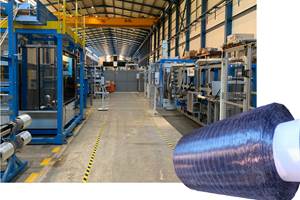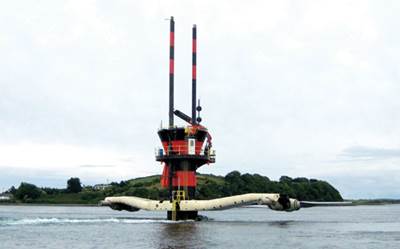Wave-energy conversion
Although wave-energy converters (WECs) lag a few years behind tidal energy systems in terms of commercial viability, there is a lot of action on the development front.
Although wave-energy converters (WECs) lag a few years behind tidal energy systems in terms of commercial viability, there is a lot of action on the development front. More than 40 companies have converters in the prototype and development phases, building on a host of underlying technologies.
Not all will succeed. A practical WEC, like its tidal-energy cousins, must offer 25-plus years of service in the field but must do so with cost-effective materials. For many, final material selections are yet to be made. But, as with tidal energy, composites could play a decisive role over the next several years as precommercial trials identify the most productive and maintainable systems.
Here’s a select sample of the many unique converter technologies that hydrokinetic power developers are exploiting in WEC systems.
Attenuator technology. Pelamis Wave Power (Edinburgh, U.K.) has developed a semi-submerged, hinged attenuator WEC, consisting of cylindrical sections connected by hinged joints. The wave-induced motion of these joints is resisted by hydraulic rams, which pump high-pressure fluid through hydraulic motors via smoothing accumulators. The motors drive generators, and the resulting electricity is cable-fed to a junction on the seabed. Several devices can be connected together and linked to shore through a single seabed cable. This summer, Pelamis’ P2 machine successfully completed its first set of trials in the outer reaches of the Firth of Forth. The machine, built for power utility E.ON, will be connected to the national grid shortly at the European Marine Energy Centre (EMEC) in Orkeny, Scotland. A second P2 device has been commissioned by Scottish Power Renewables for EMEC testing.
Oscillating water column (OWC) technology can be applied on land, but Ocean Energy Ltd. (Cork, Ireland) is one of several companies exploiting offshore concepts. In an OWC system, water enters a chamber from below the water’s surface and rises up within a shaft, pushing air up through a turbine. As the water recedes, air is pulled back through the turbine to fill the void. In Ireland’s Galway Bay the company’s quarter-scale OWC buoy logged more than 16,000 operating hours during two years in rough Atlantic waves. The next iteration of the device will likely use a HydroAir bi-directional turbine supplied by Dresser-Rand (Houston, Texas). The HydroAir is a variable radius turbine (VRT) developed for OWC applications using a combination of composites, stainless steel and marine-grade aluminum. Ocean Energy is developing a three-quarter-scale version of its device, which will be followed by a full-scale system.
Other OWC developers include Oceanlinx (North Ryde, New South Wales, Australia), which has been testing prototypes in Australia’s Port Kembla. Earlier this year, Oceanlinx launched its third-generation device, a precommercial platform called Mk3PC. The system’s patented Denniss-Auld turbine uses variable pitch blades that enable rotation in one direction as the airflow direction reverses. Mk3PC includes a glass-reinforced composite diffuser and nacelle produced by Radotec (Ingleburn, New South Wales). Connected to the power grid since March, Mk3PC supplies power to customers of local electric utility Integral Energy. Reportedly, a single Oceanlinx power unit can generate peak power outputs from 100 kW to as great as 1.5 MW.
Oscillating wave surge converters (OWSC) are designed to harness energy from near-shore bottom waves. AW-Energy’s (Vantaa, Finland) WaveRoller, for example, takes advantage of the in-and-out surge, or flow velocity, of ocean waves as they approach the shoreline. According to the company, the wave motion becomes more elliptical towards the shoreline and eventually become practically horizontal. (In the Portuguese shoreline, for instance, optimum depth is reportedly 8m/26.2 ft to 20m/65.6 ft.) The WaveRoller exploits this motion by means of a plate anchored to a base on the seabed. As the surge moves the plate, kinetic energy is transferred to the plate and collected by a piston pump. Though construction details are proprietary, the “plate” reportedly consists of GFRP wings in a steel frame on a reinforced concrete base. AW-Energy CEO John Liljelund confirms only that prototypes of the system have used E-glass reinforcement. A 10-kW prototype has operated since 2007. “Currently, we are building a 300-kW grid-connected demonstrator unit that will be deployed on the coast of Portugal during the summer of 2011,” says Liljelund. “Commercial scale devices will be 1.5-MW-plus rated.” The company reports that capacity factor for a WaveRoller plant can reach 65 percent.
Using a similar approach, Aquamarine Power’s (Edinburgh, Scotland) Oyster device incorporates a buoyant, hinged flap that is attached to the seabed at a depth of approximately 10m/32.8 ft. As the flap sways back and forth, the movement drives two hydraulic pistons that push high-pressure water onshore to drive a conventional hydro-electric turbine. A full-scale Oyster was installed at the European Marine Energy Centre (EMEC) in Orkney, Scotland, in summer 2009 and was subsequently connected to the national power grid. The company’s 800-kW Oyster 2 will be installed at the EMEC in 2011. Currently, the Oyster system is manufactured from steel, but, reportedly, the company is hoping to explore the use of other materials, such as composites and engineered wood.
Overtopping devices, such as Wave Dragon’s (Copenhagen, Denmark) self-named device, are essentially floating reservoirs that temporarily collect water in a tapered channel, then release it through hydro turbines that generate electricity. The device is meant to be moored in relatively deep water and is being constructed of a combination of reinforced concrete and steel.
Point absorbers, designed as either floating or submerged pressure differential systems, are employed by a number of developers, including the following three.
The PowerBuoy, designed by Ocean Power Technologies (OPT, Pennington, N.J.), moves freely up and down as waves rise and fall, resulting in mechanical stroking that is converted via a power take-off to drive an electrical generator. The generated power is transmitted onshore via an underwater cable. According to the company, a 10-MW PowerBuoy power station would occupy approximately 30 acres/0.121 km² of ocean space. In December 2009, the company deployed a PB40 PowerBuoy at the U.S. Marine Corps Base Hawaii (MCBH) at Kaneohe Bay. The U.S. Navy is supporting OPT in its development efforts.
Wavebob, an axi-symmetric, self-reacting point absorber that primarily operates in the heave mode and is designed by Wavebob Ltd. (Kildare, Ireland) to be deployed in large arrays offshore, has been in sea trials since 2006. It first produced electricity from the sea off the west coast of Ireland in 2007. Testing of a precommercial, grid-connected Wavebob is expected to begin off the coast of Portugal at the end of 2011.
In contrast, the AWS-III now under development at AWS Ocean Energy (Inverness, U.K.) is based on Archimedes wave-swing technology, in which seabed-anchored, point-absorbing buoys derive energy from the pressure differential caused within an air-filled cylinder as each wave rises and falls.
Related Content
Composites end markets: Energy (2024)
Composites are used widely in oil/gas, wind and other renewable energy applications. Despite market challenges, growth potential and innovation for composites continue.
Read MoreJEC World 2023 highlights: Recyclable resins, renewable energy solutions, award-winning automotive
CW technical editor Hannah Mason recaps some of the technology on display at JEC World, including natural, bio-based or recyclable materials solutions, innovative automotive and renewable energy components and more.
Read MoreRTM, dry braided fabric enable faster, cost-effective manufacture for hydrokinetic turbine components
Switching from prepreg to RTM led to significant time and cost savings for the manufacture of fiberglass struts and complex carbon fiber composite foils that power ORPC’s RivGen systems.
Read MoreNovel dry tape for liquid molded composites
MTorres seeks to enable next-gen aircraft and open new markets for composites with low-cost, high-permeability tapes and versatile, high-speed production lines.
Read MoreRead Next
Composites tap tide energy
Composites-enabled tidal stream energy projects lead the way as new forms of hydrokinetic power generation move toward commercialization.
Read MoreCFRP planing head: 50% less mass, 1.5 times faster rotation
Novel, modular design minimizes weight for high-precision cutting tools with faster production speeds.
Read MoreModeling and characterization of crushable composite structures
How the predictive tool “CZone” is applied to simulate the axial crushing response of composites, providing valuable insights into their use for motorsport applications.
Read More








.jpg;maxWidth=300;quality=90)
















